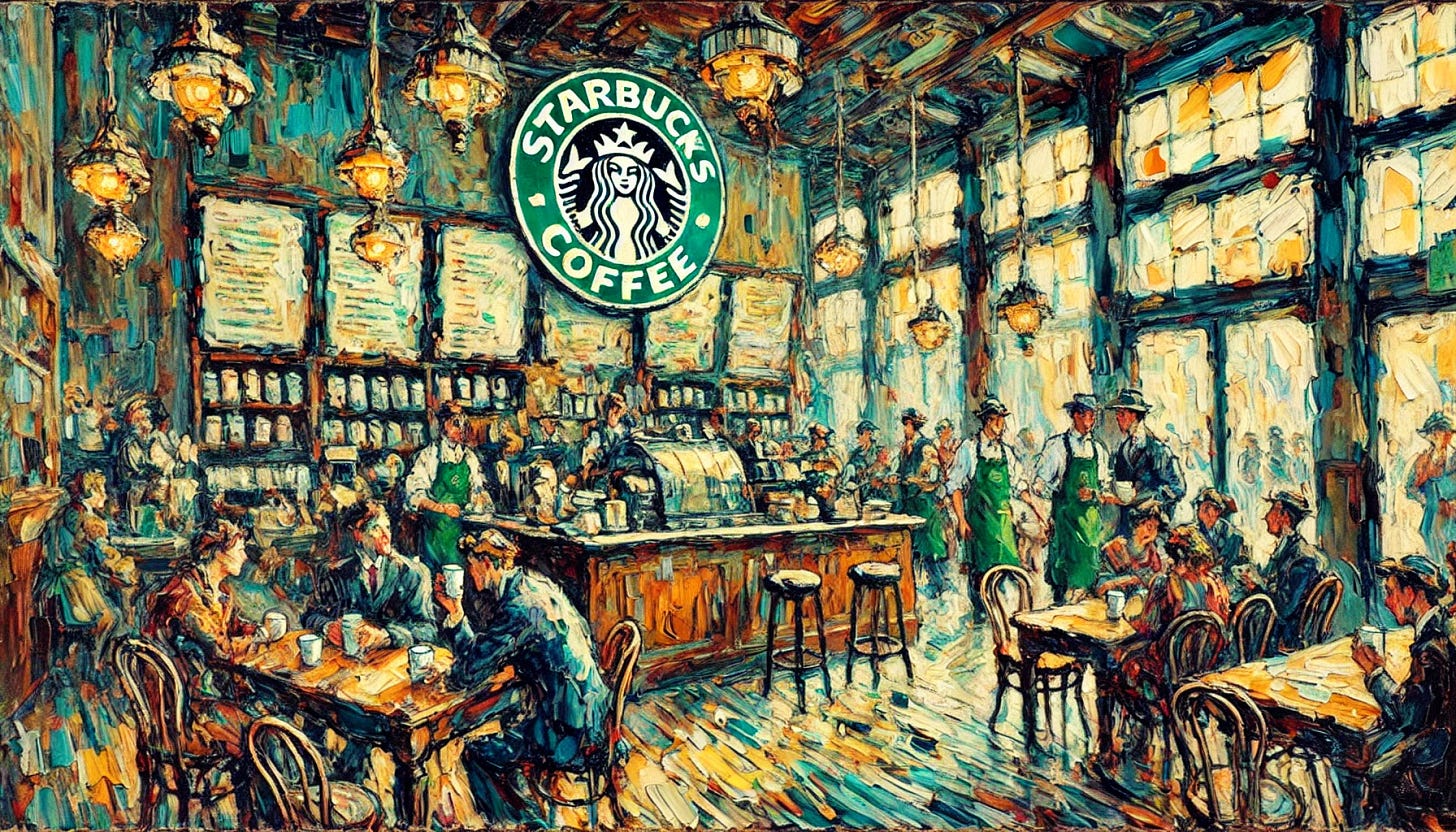GENCO MEMO-12-9-24: Starbucks' Quest to Rediscover its Soul
Business Turnaround Month Case Study No. 4.
This is the fourth installment of my December Business Turnaround Series.
We started by examining Barnes & Noble's successful localization strategy, followed by mall brands' innovative pivot to street-side locations, and then explored how banks are reimagining their physical spaces through café-style branches.
Today, I want to turn our attention to perhaps the most “close-to-home” turnaround attempt of 2024: Starbucks' bold plan to rediscover its identity under new leadership.
Here is a recent Bloomberg video describing the current situation Starbucks finds itself in and its plan to rise above it.
Here is my case study with some takeaways:
The Fall from Grace
Starbucks' recent performance tells a sobering story.
The company's fourth quarter of 2024 saw global comparable store sales decline by 7%, while consolidated net revenues dropped 3% to $9.1 billion.
In the U.S., comparable store sales fell 6%, driven by a troubling 10% decline in comparable transactions.
These numbers reflect more than just financial challenges – they signal a fundamental disconnect between the iconic coffee brand and its customers.
The Identity Crisis
The story of Starbucks' current predicament is one of gradual drift from its core identity. What began as Howard Schultz's vision of creating a "third place" – somewhere between work and home where people could gather and enjoy premium coffee – has evolved into something quite different.
Today's Starbucks experience is often characterized by:
1. Overwhelming menu complexity
2. Inconsistent product quality
3. Extended wait times
4. Hectic handoff experiences
5. A transactional rather than relational atmosphere
The "Back to Starbucks" Strategy
Enter Brian Niccol, the company's new CEO, who brings a proven track record of turnaround success from Chipotle.
His "Back to Starbucks" strategy represents a fundamental shift in direction, focusing on four key areas:
1. Partner Empowerment
The plan prioritizes empowering baristas to deliver exceptional customer service, recognizing that the human connection between baristas and customers is central to the Starbucks experience.
This includes ensuring proper staffing levels and providing necessary tools and support.
2. Morning Service Excellence
With a specific focus on improving morning peak performance, the strategy aims to deliver consistently high-quality service "on time, every time" – a direct response to customer frustration with wait times and inconsistent experiences.
3. Physical Space Transformation
The company plans to renovate stores to better reflect the original coffeehouse atmosphere, including:
Comfortable seating arrangements
Thoughtful design elements
Clear distinction between "to-go" and "for-here" service areas
Emphasis on the sights, smells, and sounds that define the Starbucks experience
4. Brand Storytelling
A renewed focus on marketing will remind customers of Starbucks' coffee expertise, community role, and unique experience, moving beyond the current narrow focus on Rewards members to reach all customer segments.
Legal and Business Strategy Implications
From the Business Law standpoint, this transformation presents several important considerations:
Labor Relations: The strategy must navigate complex labor dynamics, including ongoing unionization efforts and the need to rebuild trust with employees.
Real Estate Portfolio Management: Store renovations and format changes require careful consideration of lease agreements and property rights.
Brand Protection: The refocus on core identity necessitates renewed attention to trademark and intellectual property protection.
Regulatory Compliance: Changes in store operations and customer service protocols must align with various local and federal regulations.
The Challenge Ahead
The turnaround faces several significant hurdles:
Competition: Starbucks must contend with both traditional competitors and new entrants, particularly in markets like China where local brands such as Luckin Coffee are gaining ground.
Digital Integration: The company needs to balance digital convenience with the desired return to a more personal coffeehouse experience.
Cultural Shift: Success requires a fundamental change in corporate culture and operations while maintaining the efficiency that made Starbucks a global powerhouse.
Strategic Considerations for 2025
As businesses plan for 2025, Starbucks' transformation offers several key lessons:
Core Identity: Success often requires returning to and reinforcing fundamental brand values rather than chasing trends.
Customer Experience: The importance of balancing efficiency with authentic human connection.
Operational Simplicity: The value of reducing complexity to improve both employee and customer satisfaction.
Change Management: The need for clear communication and consistent execution during major strategic shifts.
The outcome of Starbucks' turnaround attempt remains to be seen, but the company's willingness to acknowledge its drift from core values and take decisive action provides valuable lessons for any business facing similar challenges.
That is all.
Enjoy the rest of your week.




